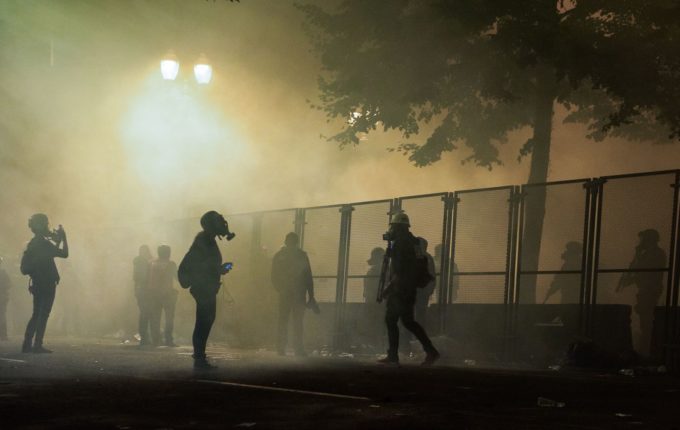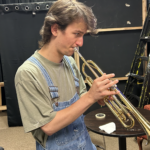[Photo: Kathryn Elsesser]
Portland residents have become heavily involved in the Black Lives Matter (BLM) movement in recent months, protesting against police brutality and systemic racism in the United States. Aggressive police tactics such as using tear gas and rubber bullets ultimately made tensions much higher, leading a small number of the protesters to loot shops and set buildings on fire.
Many people who live downtown have experienced firsthand some of the chaos that can come along with the protests, which sometimes became violent, resulting in property damage.
Leeland Sawicki, a senior who lives in the Pearl District where much of the disruptions have taken place, noted that his level of comfort in his home changed when the protests started.
“It’s definitely different than how it was before,” Sawicki said. “For me, there’s pretty much always like a lingering sense of nervousness in the back of my mind, just knowing that there’s a possibility of things going south right outside.”
According to the Portland Tribune, many retail storefronts suffered damage, including the Apple store, a Louis Vuitton outlet, a Starbucks, an H&M and an assortment of banks such as Capital One and Wells Fargo.
Eren Malone, who volunteers at the Portland Art Museum, saw some of the damage.
“I remember one day I went for a walk to Jimmy John’s for lunch, and the Wells Fargo near my house had boarded up the windows with wood planks, and there were remains of broken glass on the ground outside,” said Malone.
There was another incident where a group of protesters set fire near a Portland Police precinct, leading to the arrests of 15 people.
Due to looting and arson downtown, some residents of the area have become, at the very least, slightly worried for their personal and family’s safety. However, Veronica Derner, a sophomore who lives in downtown’s Goose Hollow neighborhood, doesn’t feel personally threatened.
“I’m honestly more worried about my little brother,” Derner said. “He’s not really old enough to really know what’s going on right now, so we just have to kind of shelter him and keep him occupied for now.”
The protests, which drew national attention, were so widespread and violent that President Donald Trump ordered federal officers to come to Portland in July to assist the police force, changing the atmosphere of the protests and escalating tensions.
“I definitely noticed a change in the feeling and vibe of the protests after the feds came, a lot of people were pissed that there were officers in full military gear who were literally abducting protesters in unmarked vans,” said Sawicki.
Diane Goodwin, who works at Hack Oregon near Pioneer Place, reported that on July 7th, just three days after federal officers arrived in Portland, tear gas had seeped into their house.
“One night I was just on my computer watching stuff, and my eyes start to tingle,” Goodwin said. “It was confusing at first, because I don’t have any allergies, but I looked outside and it was just slightly hazy, and then it connected, this is tear gas.”
This violence seems capable of shifting some residents’ stances on the protests or the BLM movement as a whole. The protests have changed some minds, but not all. Calypso Broll, a junior who participated in the protests over the summer, thinks that the violence is an important part of the movement.
“Nothing has been accomplished with peaceful protests while injustice is happening, the violence is a way to get attention, which I think is important,” said Broll.
Others said that their experience made them question if the violence was really beneficial or worth the risk of endangering families.
Malone said that she’s in support of the spirit of the protests, but not the violence.
“I definitely support what they’re protesting for, I just don’t think this is the best way to go about getting it,” said Malone. “Getting violent and setting things on fire is only going to make the Black Lives Matter movement look like a terrorist group in the eyes of the president.”
Denise Pellicier, who works in marketing with stores downtown, said that she felt like the chaos doesn’t help, it only hurts.
“I don’t think the risk of people getting hurt is worth the ‘attention’ that the protests get,” Pellicier said. “I think that donations, petitions, and voting is the best way to make change, and while the protests are definitely helping, I think the cost is just too great.”





Leave a Reply